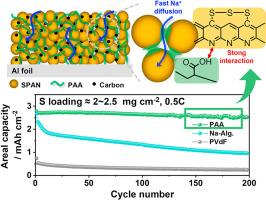Investigating the effect of binder for stabilizing a sulfurized polyacrylonitrile cathode in sodium–sulfur batteries
IF 7.9
2区 工程技术
Q1 CHEMISTRY, PHYSICAL
引用次数: 0
Abstract
Replacing elemental sulfur to sulfurized polyacrylonitrile (SPAN) as cathode is an effective strategy to alleviate the “shuttle effect”, a problem in sodium-sulfur (Na-S) batteries because sulfur atoms are covalently bonded to a conductive carbon backbone in SPAN, eliminating the dissolution of Na-polysulfides in the electrolyte solution during cycling. Nevertheless, the use of SPAN cathode with a conventional poly(vinylidene fluoride) (PVdF) binder in Na-S batteries suffers from mechanical deformation due to weak adhesion strength and environmental concerns (the use of polyfluoroalkyl substance and N–Methyl–2–Pyrrolidone solvent). To replace PVdF binder, herein, poly(acrylic acid) (PAA) and sodium alginate (Na–Alg.) are introduced as water–soluble eco–friendly binders with strong adhesive strength and systematically evaluated for their physicochemical and electrochemical compatibility with the SPAN cathode in Na–S batteries. Compared to PVdF and Na–Alg. binders, the strong interaction between the carboxyl functional group (–COOH) in PAA and the polar C=N bonds in SPAN facilitates the uniform stress distribution and enhances the structural integrity of the SPAN cathode. As a result, Na–S batteries using the SPAN cathode and PAA binder achieved the high capacity of 2.6 mAh cm−2 with a long lifespan over 200 cycles at 0.5C.

研究了粘结剂对钠硫电池硫化聚丙烯腈阴极的稳定作用
将单质硫替换为硫化聚丙烯腈(SPAN)作为阴极是缓解“穿梭效应”的有效策略。“穿梭效应”是钠硫(Na-S)电池的一个问题,因为硫原子在SPAN中共价地与导电碳主链结合,从而消除了循环过程中na -聚硫化物在电解质溶液中的溶解。然而,在Na-S电池中使用SPAN阴极与传统的聚偏氟乙烯(PVdF)粘合剂,由于附着力弱和环境问题(使用多氟烷基物质和n -甲基- 2 -吡咯烷酮溶剂)而遭受机械变形。为了取代PVdF粘结剂,本文介绍了聚丙烯酸(PAA)和海藻酸钠(Na-Alg .)作为具有较强粘结强度的水溶性环保型粘结剂,并系统评价了它们与Na-S电池中SPAN阴极的理化和电化学相容性。与PVdF和Na-Alg比较。PAA中羧基官能团(-COOH)与SPAN中极性C=N键之间的强相互作用有利于应力均匀分布,增强了SPAN阴极的结构完整性。因此,使用SPAN阴极和PAA粘结剂的Na-S电池在0.5℃下获得了2.6 mAh cm - 2的高容量和超过200次循环的长寿命。
本文章由计算机程序翻译,如有差异,请以英文原文为准。
求助全文
约1分钟内获得全文
求助全文
来源期刊

Journal of Power Sources
工程技术-电化学
CiteScore
16.40
自引率
6.50%
发文量
1249
审稿时长
36 days
期刊介绍:
The Journal of Power Sources is a publication catering to researchers and technologists interested in various aspects of the science, technology, and applications of electrochemical power sources. It covers original research and reviews on primary and secondary batteries, fuel cells, supercapacitors, and photo-electrochemical cells.
Topics considered include the research, development and applications of nanomaterials and novel componentry for these devices. Examples of applications of these electrochemical power sources include:
• Portable electronics
• Electric and Hybrid Electric Vehicles
• Uninterruptible Power Supply (UPS) systems
• Storage of renewable energy
• Satellites and deep space probes
• Boats and ships, drones and aircrafts
• Wearable energy storage systems
 求助内容:
求助内容: 应助结果提醒方式:
应助结果提醒方式:


